
What is a package of bees?
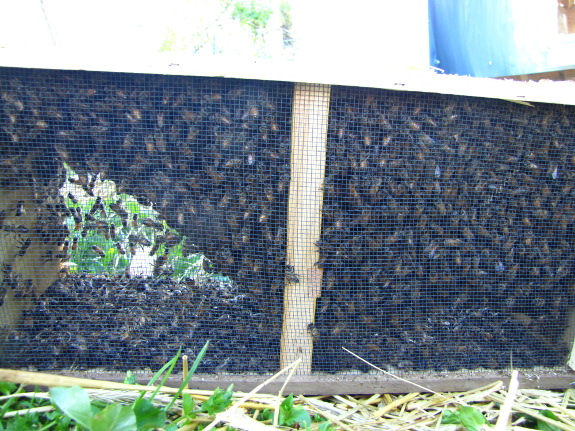
The first task for most
beginning beekeepers is to install a package of bees. It feels
like trial by fire, with bees whirling and buzzing around your
head. But if you know what to expect, hiving a package is
actually easy and fun. This week's lunchtime series walks you
through installing a package of bees into a top bar or Warre hive, and this post starts with
the very basics --- what is a package?
If you order bees
through the mail, they'll almost certainly come in what's called a
"package". A package consists of a screened box full of a bunch
of worker bees, a queen bee, and some sugar syrup to keep them all
alive until they reach your house.
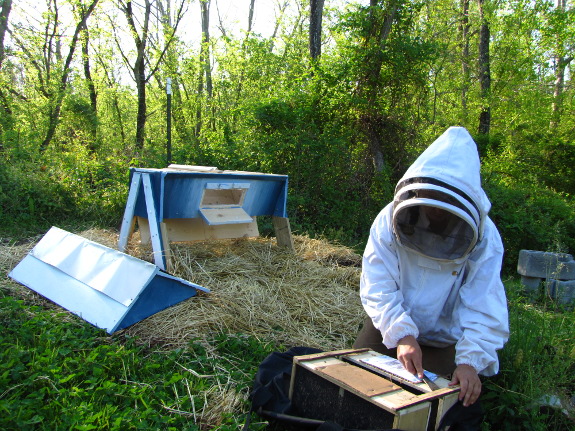
Yes, the package ships
as is, with bees separated from the outdoors only by the mesh sides of
the container. (If you order more than one package of bees, they
may arrive attached together, as is shown in the photo above.)
Postal employees seem much less charmed by packages of bees than they
are by boxes of chicks, so it's especially important to call your post
office or UPS guy
and set up a delivery plan the day before your bees arrive. You
don't want the bees to be set outside on a sunny, windy, or rainy
delivery dock while they wait for you to pick them up.
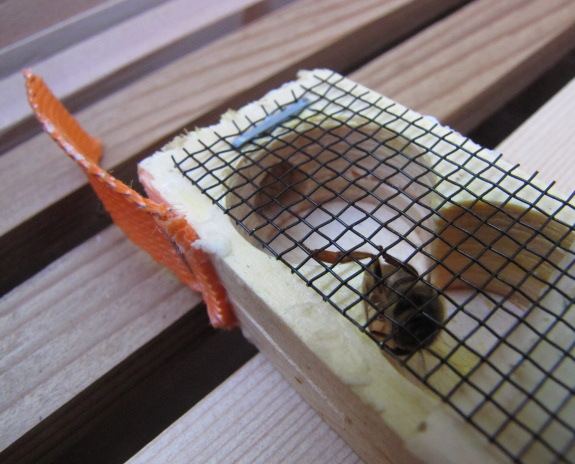
In the U.S., most
packages are 3 pounds, which simply means you get three pounds of
worker bees (10,000 to 12,000 bees). Don't be too concerned if
you see up to an inch of dead bees in the bottom of the package ---
it's hard for bees to be shipped across the country, so apiaries put in
enough workers that your hive will be able to take off despite moderate
losses.
In addition to the
worker bees, your package also contains a queen, who is housed in a
cage like the one shown above. At large apiaries, queens are
raised separately from the worker bees, so the 12,000 bees loose in
your package haven't been fully acquainted with the queen by the time
they arrive at your homestead. In other words --- the workers
want to kill the queen. After two or three days, the workers will
become used to the queen's scent and will (hopefully) be ready to take
her into their midst, but until then, the matriarch stays segregated
with some semi-solid sugar candy to nibble on.
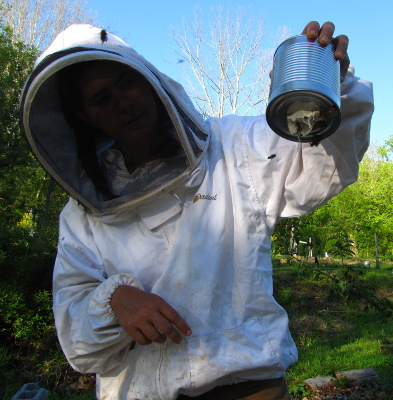 Here's the can of syrup, the
final component of your package. Depending on who you buy from,
the can may have holes punched in the bottom with a nail or might
contain a fabric feeding entrance (as is shown here). Either way,
the idea is that the bees can get a little bit of sugar-water at a time
without drowning.
Here's the can of syrup, the
final component of your package. Depending on who you buy from,
the can may have holes punched in the bottom with a nail or might
contain a fabric feeding entrance (as is shown here). Either way,
the idea is that the bees can get a little bit of sugar-water at a time
without drowning.
That's all there is to
the physical package of bees, but you should also take a minute to
understand the psychology of your new friends. A package 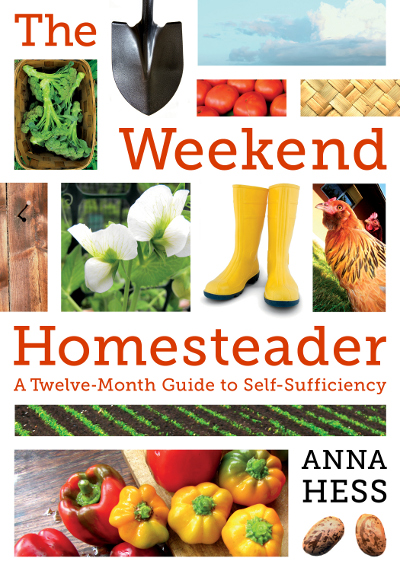 mimics a swarm --- bees hunting for a home
--- which means they're going to be gentle and only interested in
hanging out around their queen. Stay tuned for tomorrow's post in
which I'll show you how to put these new livestock in a hive!
mimics a swarm --- bees hunting for a home
--- which means they're going to be gentle and only interested in
hanging out around their queen. Stay tuned for tomorrow's post in
which I'll show you how to put these new livestock in a hive!
Does raising honeybees sound too
daunting? Learn easy ways to attract native pollinators in Weekend
Homesteader.
| This post is part of our Bee Package lunchtime series.
Read all of the entries: |
Want more in-depth information? Browse through our books.
Or explore more posts by date or by subject.
About us: Anna Hess and Mark Hamilton spent over a decade living self-sufficiently in the mountains of Virginia before moving north to start over from scratch in the foothills of Ohio. They've experimented with permaculture, no-till gardening, trailersteading, home-based microbusinesses and much more, writing about their adventures in both blogs and books.
Want to be notified when new comments are posted on this page? Click on the RSS button after you add a comment to subscribe to the comment feed, or simply check the box beside "email replies to me" while writing your comment.

If you buy "Package" bees, you need to feed them. FEED, FEED, FEED. Here's why: They are starting behind the 8 ball. 1. The 3 pound of bees didn't all come from one hive and the queen isn't their queen. Queen has to seduce the workers with her pheromones before they free her from the queen cage. This doesn't always work and sometimes they will kill the queen. This seldom happen with a package but does occasionally. This takes time. On average I'd say a week. A week with no eggs. 2. The have has NO HONEY. ZERO. They are 100% dependent on sugar syrup. 3. The workers have to build comb. Comb building [wax making] takes more energy than honey production. Without comb, you do have have a hive. You have a bunch of bees. The comb is the tool that make everything else possible and it take energy to build it. 4. Once the queen is out and some comb is built, then and only then can she start to lay eggs. It will take 21 days for the eggs to come out as an adult bee. That bee then becomes a "house bee" for approx 21 days doing various important jobs around the hive. Then the bee become a forager. A total of ~42 days from egg to making honey. 5. In the mean-time, the bees are dying. The package is made up of all types of bees. Most farms package their bees during the day to get mostly "house bees" because they are younger but a bee only lives for 1-4 months. In summation, the bee population of the new hive crashes and the first new forager that actually came from the new hive took ~49 days to start making honey. Almost all of the early nectar goes to making comb and keeping the bees alive. Give your bees a fighting chance and feed them I'm amazed that it works at all.
--Mike
schomestead.com
P.S. I buy nucs because they are just a small hive (queen, workers, eggs, larvae, honey and comb) they are just hard to ship. It's best to find a local source.
Michael --- We considered buying nucs, but everyone locally believes in mainstream chemical treatments, so I figured I'd be better off to get survivor bees from afar than a local nuc that would have to be nursed along with miticides, etc.
I've been wondering how long to feed a package. From your analysis, it sounds like they should really keep getting fed for six to seven weeks to be on the safe side.
Anna-- I'd rather over feed than loose a hive as I did last year. (because I didn't feed enough)
--Mike
schomestead.com